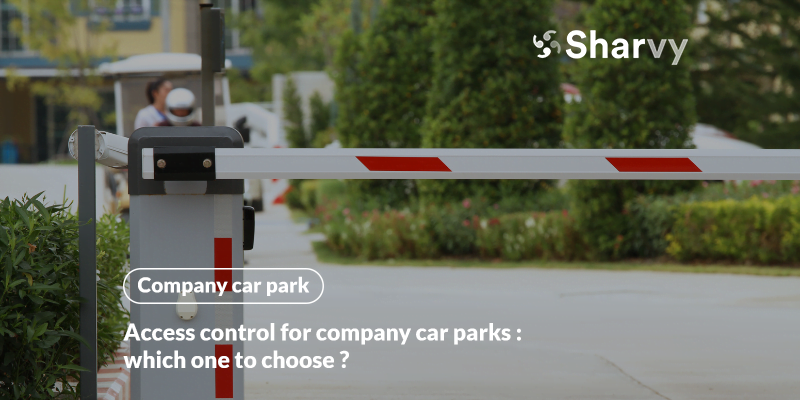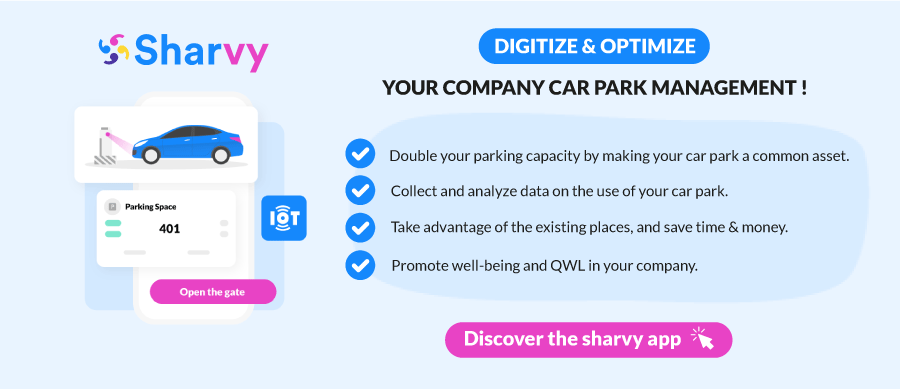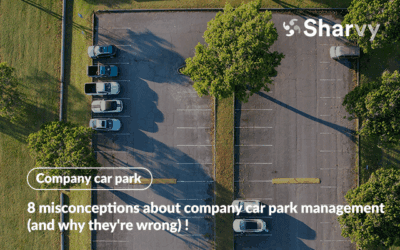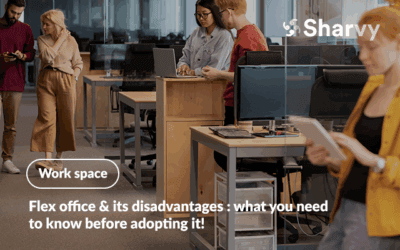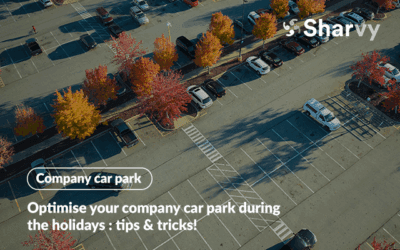Nowadays, to guarantee the security of a company’s premises, it is not enough to control the comings and goings of pedestrians. Beyond that, it is also essential to install a vehicle access control system.
This is apparent: the number of access to a company is increasing all the time! Whether it’s the simple entrance “door”, the emergency access, the car park(s), also the delivery and/or unloading areas. These are all access points through which it can be tempting for people outside the company to break in.
In this article, we will discuss the existing access control systems for company car parks and their advantages for the employees and the company.
Why is it important to install an access control system in a company car park?
According to an Ipsos study published in the first quarter of 2022, 75% of French people make their home-to-work journeys by car.
Consequently, the company car park is the entry point to their work environment for many employees. For visitors, it is also the first point of contact with the company.
However, welcoming and improving the parking experience of employees and visitors alike is an essential element that companies should pay more attention to! Regularly, there is a queue at the company’s lift gates and a problematic and/or slow means of identification.
In other words, a familiar feeling of lack of fluidity and comfort! This is why the question of accessibility and security access to the car park is now a significant issue for companies.
Especially since, without an (optimal) access control system, it may be tempting for people outside the company to access the car park & gain access to the car park :
- Access the car park & occupy the spaces reserved for company employees
- To come and vandalize/steal vehicles and/or equipment present in the car park.
This is why, to dissuade this type of crime and to avoid any risk of incident, it is essential to secure access to the company car park!
Four examples of access control to company car parks!
Today, several devices offer companies optimal access control to their car park. For this reason, finding a gate, a security barrier, and/or retractable access control bollards at the entrance to all company access roads is expected.
However, for these systems to be activated, they must be connected to an electric strike mechanism or an automatic system that permits moving around. So let’s take a look at what these devices are and what their advantages and disadvantages are!
1. A human presence
It is common for companies to opt for a receptionist, a guard, and/or a surveillance officer who controls the flow of people into and out of their car park. The guard is also responsible for preventing any malicious acts. Therefore, they help companies to fill a security gap and/or reinforce the presence of surveillance cameras.
There are many advantages to choosing this type of access control!
On the one hand, you are using a person who is a security expert. But on the other hand, he (usually) has the necessary training, skills, and competencies to carry out this work.
He also masters video surveillance & alarm systems, which allows him to leave nothing to chance and be vigilant and attentive to the smallest detail. He knows how to spot suspicious behavior and how to react accordingly.
However, you should remember that this solution’s major, if not the only, disadvantage is its cost since, to be effective, this surveillance must be carried out 24/7!
2. RFID card & badge readers
RFID cards & badge readers are IT solutions that filter, control, and authorize the incoming and outgoing flows of visitors and employees.
Today, the RGPD severely restricts the use of these practices in France! In parallel, the CNIL regularly monitors and acts against abuses of its implementation. This is why it is an access control technology often favored by companies.
However, managing access to this type of access control is a time-consuming and very tedious task for companies. Not only do they have to collect the request for access to the car park, create a badge and/or an RFID card, assign a user to it, set up the parameters in the HR management software, and send it to the employee.
At the same time, and over the longer term, losses must be dealt with; the car park barrier must be opened if the badge is forgotten, the badge must be recovered at the end of the employee’s contract and made anonymously, etc. All these elements make this task a constraining one with little added value.
Finally, this may not be the optimal solution, as RFID cards & badges can easily be exchanged and/or lent between employees. This means that you cannot (really) be sure who is accessing the car park, and whether or not they have a parking space.
3. Camera with plate recognition
These ANPR cameras, installed near the company’s barrier and/or gate, are technologies designed to identify the number plates of vehicles using character recognition algorithms.
Companies that opt for this access control only have to provide a list of the number plates of the vehicles of employees authorized to enter the car park. Then, when the latter arrives in front of the camera, it will automatically activate the opening of the barrier and/or the gate if the user has access to the car park.
The advantages of this car park access control are numerous!
On the one hand, it makes it easier and more fluid for employees and visitors to enter the company. It is a reliable device & capable of identifying different number plate formats, authorizing access to vehicles very quickly, or conversely, directing unrecognized cars to a transit zone, with a guard post, for example.
On the other hand, it is a specific device to deploy and operate for car park managers! Therefore, when installing, you need to pay attention to the angle of view and the lighting quality for the system’s effectiveness. In addition, the camera should be in line with the vehicle to obtain a clear image of the plate and, if possible, protect it from impact or vandalism.
4. The IoT module
To make access to the company car park more fun, opting for an IoT module directly connected to the automatic barrier and/or the company gate is possible.
Thanks to this module, your employees’ smartphones become a remote control capable of opening the gate and/or security barrier on demand. In addition, for more security, the opening of the barriers can be limited according to the users’ IP addresses.
To operate, nothing could be easier! First, you download an application dedicated to managing your car park and then create your employees’ accounts. There are various applications, all different and offering various functionalities.
However, the Sharvy application is intuitive & easy to use for your employees. Not only does it allow your company to set up an effective access control system, but it also allows you to :
- Create rules for the proper use of your company car park
- Define systems for prioritizing or sharing spaces between users
- Establish rules of equity between employees to limit parking problems
- Offer your employees the possibility to anticipate their arrival & reserve a space
- Unify access control & management of your multisite car parks!
- Analyse the occupancy rate of your car park
- Etc.
Which access control system should you choose for your company car park? Our advice!
It is well known that access control systems are an essential part of a company’s security strategy. However, when faced with diverse solutions, which should you choose according to your needs? Discover our 4 tips for making your choice!
Tip 1 : Choose a camera to facilitate the management of waiting areas and vehicle flows!
For many logistics companies, the car park is the main access route for HGVs to make deliveries/pick-ups.
Consequently, to limit the inconvenience to users and make access to the car park more fluid, it is a good idea for these companies to install a number plate recognition camera as access control.
The list of number plates authorized to access the car park is provided and transferred to the camera beforehand. This means that when an employee’s and/or visitor’s vehicle arrives at the security barrier, the barrier opens automatically if the employee or visitor has an assigned parking space or a reservation for the day.
HGVs and other delivery/pick-up vehicles can access the car park and be directed directly to transit zones and/or destination docks. This avoids unnecessary queues due to pending deliveries and limits the maneuvering of trucks in the vicinity of employees’ and/or visitors’ vehicles.
In addition, this technology should also be chosen if the entrance to your car park is located in a busy area. The security barrier opens automatically when your employees’ and/or visitors’ vehicles approach. This way, they can save time looking for their badges and/or RFID cards! As a result, you :
- Improve the parking experience & the employee experience
- Reduce traffic jams during peak hours
- Improve traffic flow around your car park!
Tip 2 : Favor the IoT module or camera to reconcile fluidity & security!
Nowadays, and in the face of technological advances, RFID readers & badges are no longer as effective and secure as they once were. Indeed, employees and visitors can exchange and/or lend each other their access badges. Moreover, these badges can easily be stolen and/or lost and end up in the hands of malicious people!
If these risks seem secondary for many companies, this is certainly not the case for others! In particular, companies store sensitive equipment and/or data, dangerous products, high-value items, weapons, or significant funds. For many, the company car park is a gateway to the premises and these restricted areas.
That’s why, if this is your case, installing an IoT module linked to a dedicated application or a plate recognition camera is more prudent to achieve stricter access screening and seamless security.
Beyond that, these technologies provide you with a greater level of analysis. For example, in the event of problems, you can more easily determine how long a given vehicle has been parked, with its arrival and departure times l space used.
Tip 3 : Choose the IoT module for quicker implementation & a smaller budget!
Before choosing your “ideal” access control technology, you should ask yourself several questions relating to your objectives, the organization of your company, and the configuration of your car park… But also, according to the size of your available budget.
Not surprisingly, the technology behind a plate recognition camera, such as Artificial Intelligence (AI) & Deep Learning to validate and/or refuse action is only available to some companies! Indeed, its purchase & installation has a specific cost : on average, it is around 1800 euros.
In parallel, and depending on the model, the delivery time can be (relatively) long! Therefore, if your project (moving, fitting out, reorganizing the car park, etc.) is coming up fast, there are better choices.
In this case, opting for an IoT module linked to a dedicated mobile application and connected to your security gate’s automation is preferable. Less expensive, faster & easier to set up, it is just as reliable in terms of security.
Tip 4 : Opt for a hybrid solution to combine flexibility and performance!
Rather than choosing a single technology, consider a hybrid solution combining several devices. This allows you to benefit from the specific advantages of each technology while meeting the varied needs of your company car park. For example:
- Cameras with plate recognition (ANPR) to improve fluidity at main entrances and manage flows at peak times.
- Connected IoT modules for regular employees, guaranteeing reliable security and rapid implementation.
- RFID badges for visitors and occasional service providers.
A hybrid solution is particularly relevant if your car park serves a diverse audience (employees, visitors, logistics) or if your company plans to expand rapidly. It offers flexible access management while avoiding excessive investment in a single technology.
The Sharvy solution for simplified access management & autonomous users!
Available on computer, tablet, and/or mobile, the Sharvy solution allows you to transform the passive management of your car park into intelligent and active management.
Therefore, in addition to optimizing the occupancy rate of your car park & facilitating its management, the application allows you to manage the access control to the car park!
In a single application, it is possible to :
- To unify the access management of all your company’s sites
- Offer your employees visibility of the availability of parking spaces on the sites
- Simplify the reservation and release of spaces in all car parks
- Monitor site occupancy rates & adapt your parking policy
- Improve the parking experience, whatever the type of user (permanent employees, rotating employees, temporary visitors, delivery personnel, etc).
The little extra? Sharvy advises you and helps you choose and implement your access control system. Moreover, this SaaS solution is compatible with many systems, whether it be: existing RFID readers & badges, IoT modules, plate recognition cameras, etc.
Curious about the benefits of the application in this respect? Please take a look at our customer cases!
In conclusion
Beyond restricting entry and exit, access control to company car parks is emerging as a fundamental pillar of security, resource management, and quality of working life within an organization.
What’s more, the importance of access control extends beyond the security aspects, positively influencing the general perception of the working environment. Therefore, investing in car park access control solutions is wise for companies seeking to reconcile security, operational efficiency, and employee well-being.
Have a question? Check out the following FAQ!
By the way, what does RFID stand for?
RFID stands for Radio Frequency Identification. It is a technology that uses radio waves to establish short-range, high-frequency wireless communication, resulting in the exchange of information between electronic devices.
In other words, it allows various data to be transmitted and stored to identify objects, animals, and/or people uniquely.
It is a widespread technique in our daily lives! For example, it is used when using contactless payment.
How do you assess the durability of the chosen access control system?
Ensuring the durability of your system is of paramount importance! To help you, check that the selected method corresponds to your company’s issues and/or problems encountered today. Indeed, verifying the adequacy between the chosen access control system and your current needs is crucial. Then ask yourself various questions: does this system simplify the user experience? What aspects of the system might be unsatisfactory? What areas of improvement could be explored? Finally, ask yourself whether the system can evolve and adapt to your organization’s new needs.
How to choose the right access control system to secure a company car park?
Choosing the right access control system for a company car park depends on several criteria related to the security and supervision of vehicle entry and exit. It is crucial to consider the required level of security, available locations, and the specific needs of users, such as people with reduced mobility (PRM).
Among the available options, badge readers, biometric terminals, and integrated video surveillance systems with a digital solution for access traceability offer varying levels of authentication and control. Automated systems also allow for smooth management of available spaces and access permissions for drivers.
For companies looking to optimize security, a centralized system that combines multiple technologies, such as intercoms, controlled elevators, and access control systems connected to a global information system, can offer effective supervision and prevent intrusion attempts. This type of solution allows for real-time access control, management of access rights, and rapid incident detection while providing an optimized user experience for parking within the company.
Want to learn more? Check out our latest articles!
8 misconceptions about company car park management (and why they’re wrong)!
Discover 8 misconceptions about company car park management and learn the truth to optimise your parking management!
Flex office & its disadvantages : what you need to know before adopting it!
What is the flex office? How does it work? What are its drawbacks and how can you overcome them? Find the answers in this article!
Optimise your company car park during the holidays : tips & tricks!
How can you reinvent your company car park management during the holidays? What solutions and tips can you come up with? Focus!
Subscribe to our newsletter!
Resources
Contact us
+44 117 463 6990

